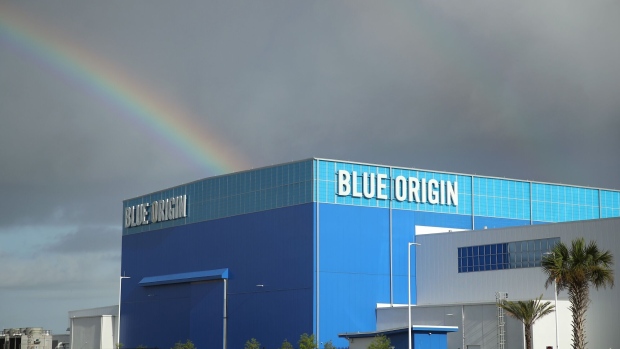May 19, 2023
NASA Taps Bezos’ Blue Origin for Moon Lander Worth $7 Billion
, Bloomberg News

(Bloomberg) -- NASA is tapping Jeff Bezos’ Blue Origin to develop a second passenger lunar lander for the space agency’s Artemis program, which aims to send humans back to the moon before the end of the decade.
The closely held company will join Elon Musk’s SpaceX as one of two companies developing a lander for the program, NASA said Friday in a statement. Blue Origin is working with partners including Boeing Co. and Lockheed Martin Corp.
“We want competition. We want two landers,” NASA Administrator Bill Nelson said at a press conference, noting the program relies on public-private partnerships. “It helps NASA share the technical risk and the financial risk.”
NASA said its fixed-price contract is worth about $3.4 billion and Blue Origin said it will match that amount for a total cost of around $7 billion.
Blue Origin will develop its Blue Moon lander, a spacecraft design the company unveiled back in 2019. To get to the moon, the lander will launch on top of Blue Origin’s next-generation New Glenn rocket.
The goal is for Blue Moon to be ready to carry humans to the moon for NASA’s Artemis V mission, the fifth major flight in the program. With the stated goal of landing the first woman and the first person of color on the moon, the Artemis program aims to create a sustainable human presence on the lunar surface, by launching a series of human flights to the moon’s vicinity over the next decade.
“That’s our goal — to get to that yearly cadence with Artemis V,” James Free, NASA’s associate administrator for exploration systems development said at the briefing.
During the Artemis V mission, tentatively scheduled for 2029, the lander is meant to carry humans to the surface from a space station NASA is hoping to build around the moon.
Turning Point
The contract represents a major win for Blue Origin, which has been vying for years to be part of the Artemis program. The company, along with an original team that included Lockheed Martin and Northrop Grumman, submitted a lander bid in 2019, when NASA first issued a call for proposals from the space industry.
NASA narrowed down the selection to three finalists: SpaceX’s next-generation Starship vehicle, Blue Origin and a human landing system from the company Dynetics.
Originally, NASA wanted to select two companies to build landers, but after the agency received less funding than expected, the agency only selected SpaceX, largely due to its low asking price.
NASA awarded SpaceX a contract worth $2.9 billion to get Starship ready to fly on Artemis III, the mission that is meant to bring the first humans to the moon in more than half a century.
Suing NASA
Blue Origin and Dynetics protested the decision through the Government Accountability Office. When those efforts failed, Blue Origin sued NASA. At one point, Bezos offered to build the lander at a substantial discount to what had been proposed. Ultimately, the lawsuit failed and Blue Origin vowed to accept the decision.
However, certain lawmakers also weren’t happy with NASA. Maria Cantwell, a Democratic senator from Washington state where Blue Origin is located, proposed an amendment to the then-Endless Frontiers Act in 2021 that would require NASA to reopen the lunar lander competition and give the agency $10 billion to fund the effort.
While that language did not make it into the final version of legislation that was enacted, NASA ultimately decided to reopen the selection process in 2022.
The agency wound up receiving about $1.2 billion for fiscal year 2022 to develop human lunar landing systems, the full amount it had requested. And in 2023, NASA received nearly $1.5 billion to support development of both Starship and a second lander, which will now be Blue Origin’s.
(Updates with background information beginning in eighth paragraph.)
©2023 Bloomberg L.P.


